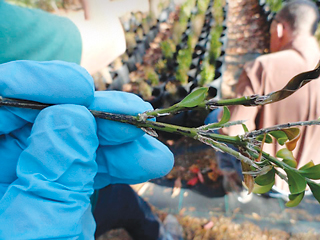Many plants in local landscapes are rebounding from this past winter. The erratic temperatures killed back the above-ground portions of plants we love, such as hydrangeas, gardenias, and boxwood.
The good news is these plants will rebound as new growth originates from roots. For boxwood, however, there is more bad news. The disease is boxwood blight, and it is moving through the Virginia landscape. Caused by the fungal pathogen, Cylindrocladium pseudonaviculatum, boxwood blight has been a battle for gardeners in Europe since the mid-1990s. In 2011, it was found in North Carolina, Virginia, and Connecticut. While the disease does not kill the boxwood roots, it weakens the plant and allows other diseases to cause further decline, ultimately leading to death. Once a plant is infected, the only course for control is to remove the infected plants, along with the clean plants immediately around the infected ones, the top few inches of mulch, and all debris and soil. All of this is done in an effort to remove spores on the ground. The boxwoods and all this natural waste must be double-bagged and disposed of at the landfill. The handlers must launder their gloves and all of their clothing twice to insure the sticky fungal spores have been washed away. Finally, footwear must be thoroughly cleaned.

To make a proper diagnosis, it is important to learn about this highly infectious disease. First, leaves and branches infected with boxwood blight have light or dark brown leaf spots, bordered with a dark edge that is easily visible. In comparison, plants suffering from winterkill (stress from this year’s inconsistent weather) do not have the ringed brown leaf spots. Second, infected branches or stems develop long blackish brown streaks that are easy to see. Third, as the humidity rises, the fungus produces clusters of white spores that look like little cotton balls on the underside of leaves and on the infected stems.
All fungi produce spores, and boxwood blight spreads easily due to the sticky nature of its particular kind of spores. These microscopic spores stick to animals, clothing, footwear, or just about anything that brushes up against an infected plant. Blight spores are extremely light and are carried easily by the wind or by leaf blowers that are so popular these days.
The disease is difficult to control with fungicides, which is why removal is prescribed by the Virginia Department of Agriculture and Consumer Services (VADACS). Due to the sticky nature of the long-active spores, the extensive removal procedure is the best course of action for control. Once infected plants and soil have been removed, you should consider planting a different type of plant. Cylindrocladium pseudonaviculatum only infects boxwood, (Buxus sp.) and nothing else.
In response to the threat, the voluntary Boxwood Blight Cleanliness Program has been developed for nursery professionals. Participating nurseries agree to use best management practices to reduce the risk of introducing and spreading boxwood blight. For a list of participating nurseries in Virginia, visit vdacs.virginia.gov. You should ask your local garden center if their boxwood supplier is on the safe list.
Another important step to prevention is to be proactive, but here’s a cautionary tale: One homeowner with an extensive boxwood garden hired a firm to care for her plants. Unfortunately, the blight was brought in on the workers’ clothing, and infected the whole garden as they moved about doing their business. Be sure to ask your landscaping company or crew if they are aware of the challenges of boxwood blight to insure the disease is not transferred from one garden to another.
As they say, knowledge is power, and knowing the details of this disease will help protect the many beautiful boxwoods in Virginia’s landscapes.




